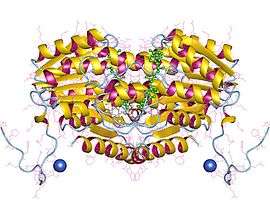11β-Hydroxysteroid dehydrogenase
| 11-beta-hydroxysteroid dehydrogenase (NADP+) | |||||||||
|---|---|---|---|---|---|---|---|---|---|
|
11-beta-hydroxysteroid dehydrogenase 1, dimer, Human | |||||||||
| Identifiers | |||||||||
| EC number | 1.1.1.146 | ||||||||
| CAS number | 9041-46-7 | ||||||||
| Databases | |||||||||
| IntEnz | IntEnz view | ||||||||
| BRENDA | BRENDA entry | ||||||||
| ExPASy | NiceZyme view | ||||||||
| KEGG | KEGG entry | ||||||||
| MetaCyc | metabolic pathway | ||||||||
| PRIAM | profile | ||||||||
| PDB structures | RCSB PDB PDBe PDBsum | ||||||||
| Gene Ontology | AmiGO / EGO | ||||||||
| |||||||||
11β-Hydroxysteroid dehydrogenase (HSD-11β or 11β-HSD) is the name of a family of enzymes that catalyze the conversion of inert 11 keto-products (cortisone) to active cortisol, or vice versa,[1] thus regulating the access of glucocorticoids to the steroid receptors:
- 11β-hydroxysteroid + NADP+ ⇌ an 11-oxosteroid + NADPH + H+
Thus, the two substrates of this enzyme are 11beta-hydroxysteroid and NADP+, whereas its 3 products are 11-oxosteroid, NADPH, and H+.
This enzyme belongs to the family of oxidoreductases, specifically those acting on the CH-OH group of donor with NAD+ or NADP+ as acceptor. The systematic name of this enzyme class is 11beta-hydroxysteroid:NADP+ 11-oxidoreductase. Other names in common use include corticosteroid 11β-dehydrogenase, β-hydroxysteroid dehydrogenase, 11β-hydroxy steroid dehydrogenase, corticosteroid 11-reductase, and dehydrogenase, 11β-hydroxy steroid. This enzyme participates in c21-steroid hormone metabolism and androgen and estrogen metabolism.
Structural studies
As of late 2007, 8 structures have been solved for this class of enzymes, with PDB accession codes 1XSE, 1XU7, 1XU9, 1Y5M, 1Y5R, 2BEL, 2ILT, and 2IRW.
Function

Cortisol, a glucocorticoid, binds the glucocorticoid receptor. However, because of its molecular similarity to aldosterone it is also capable of binding the mineralcorticoid receptor. Both aldosterone and cortisol have a similar affinity for the mineralocorticoid receptor; however, there is vastly more cortisol in circulation than aldosterone. To prevent over-stimulation of the mineralocorticoid receptor by cortisol, HSD-11β converts the biologically active cortisol to the inactive cortisone, which can no longer bind to the mineralocorticoid receptor. 11β-HSD co-localizes with intracellular adrenal steroid receptors. Licorice, which contains glycyrrhetinic acid, or enoxolone can inhibit 11β-HSD and lead to a mineralocorticoid excess syndrome.
Isoforms
In humans, there are two HSD11B isoforms:[2][3]
| HSD11B1 | NADPH-dependent | Highly expressed in key metabolic tissues including liver, adipose tissue, and the central nervous system. | In these tissues, HSD11B1 reduces cortisone to the active hormone cortisol that activates glucocorticoid receptors. |
| HSD11B2 | NAD+-dependent | Expressed in aldosterone-selective tissues, including kidneys, liver, lungs, colon, salivary glands, HSD2 neurons and placenta. | In these tissues, HSD11B2 oxidizes cortisol to cortisone and prevents illicit activation of the mineralocorticoid receptor. |
Inhibition of HSD11B1 has been suggested as a possible therapy for treatment of obesity and metabolic syndrome.[3]
See also
- Steroidogenic enzyme
- 11β-Hydroxysteroid dehydrogenase type 1
- 11β-Hydroxysteroid dehydrogenase type 2
- Cortisone reductase deficiency
References
- ↑ Seckl JR, Walker BR (April 2001). "Minireview: 11beta-hydroxysteroid dehydrogenase type 1- a tissue-specific amplifier of glucocorticoid action". Endocrinology. 142 (4): 1371–6. PMID 11250914. doi:10.1210/en.142.4.1371.
- ↑ Seckl JR (January 1997). "11beta-Hydroxysteroid dehydrogenase in the brain: a novel regulator of glucocorticoid action?". Front Neuroendocrinol. 18 (1): 49–99. PMID 9000459. doi:10.1006/frne.1996.0143.
- 1 2 Anagnostis P, Athyros VG, Tziomalos K, Karagiannis A, Mikhailidis DP (2009). "Clinical review: The pathogenetic role of cortisol in the metabolic syndrome: a hypothesis". The Journal of Clinical Endocrinology and Metabolism. 94 (8): 2692–2701. PMID 19470627. doi:10.1210/jc.2009-0370.
- Agarwal AK, Monder C, Eckstein B, White PC (1989). "Cloning and expression of rat cDNA encoding corticosteroid 11 beta-dehydrogenase". J. Biol. Chem. 264 (32): 18939–43. PMID 2808402.
- Bush IE, Hunter SA, Meigs RA (1968). "Metabolism of 11-oxygenated steroids. Metabolism in vitro by preparations of liver". Biochem. J. 107 (2): 239–58. PMC 1198650
 . PMID 4384445.
. PMID 4384445. - Lakshmi V, Monder C (1988). "Purification and characterization of the corticosteroid 11 beta-dehydrogenase component of the rat liver 11 beta-hydroxysteroid dehydrogenase complex". Endocrinology. 123 (5): 2390–8. PMID 3139396. doi:10.1210/endo-123-5-2390.
- Phillips DM, Lakshmi V, Monder C (1989). "Corticosteroid 11 beta-dehydrogenase in rat testis". Endocrinology. 125 (1): 209–16. PMID 2661206. doi:10.1210/endo-125-1-209.
External links
- 11-beta-Hydroxysteroid Dehydrogenases at the US National Library of Medicine Medical Subject Headings (MeSH)

